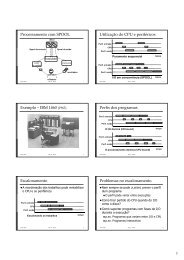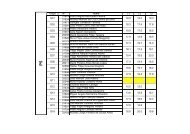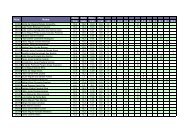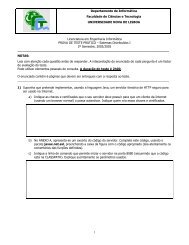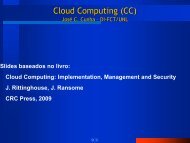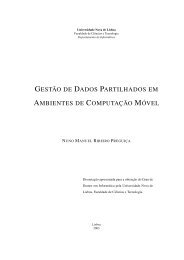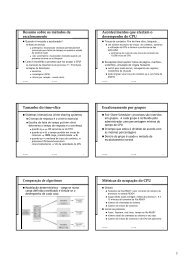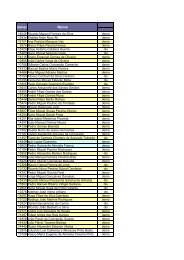Dissertaç ˜ao de Mestrado Mestrado em Engenharia Informática Jo ...
Dissertaç ˜ao de Mestrado Mestrado em Engenharia Informática Jo ...
Dissertaç ˜ao de Mestrado Mestrado em Engenharia Informática Jo ...
Create successful ePaper yourself
Turn your PDF publications into a flip-book with our unique Google optimized e-Paper software.
2. STATE OF THE ART AND RELATED WORK 2.1. Virtual Appliances<br />
The virtualization concept goes back to the 1960s when corporate mainframes were in a<br />
severe un<strong>de</strong>rutilization state [oV08]. By then, some IBM research personnel were working on<br />
the CP-40 OS <strong>de</strong>signed to run on the Syst<strong>em</strong>/360 time-sharing syst<strong>em</strong>. It was the first OS to<br />
completely virtualize a syst<strong>em</strong> (namely Syst<strong>em</strong>/360) so that other S/360 OSes could be tested<br />
and executed. This syst<strong>em</strong> paved the way for virtualization as known nowadays and concepts<br />
pioneered by CP-40 are still actual, like the case where an abstraction layer catches traps and<br />
simulates th<strong>em</strong>. Curiously, CP-40 is still supported by IBM mainframes (Syst<strong>em</strong> z10). Presently,<br />
mainframes came to suffer from the same un<strong>de</strong>rutilization probl<strong>em</strong> and so virtualization is en<br />
vogue once again.<br />
2.1.2 Motivation<br />
Nowadays, <strong>de</strong>ployment via download or DVD <strong>de</strong>fines the typical software distribution mo<strong>de</strong>l.<br />
Despite its simplicity, this mo<strong>de</strong>l features limitations such as <strong>de</strong>ployment and configuration<br />
complexity. Other flaws that might be pointed are the huge number of application versions to<br />
maintain, which leads to IT resources draining; having to cope with a myriad of hardware plat-<br />
forms, which leads to intensive time-consuming testings; In<strong>de</strong>pen<strong>de</strong>nt Service Vendors (ISVs)<br />
might see their revenues <strong>de</strong>creased since if the customer is content with the product, he will<br />
only upgra<strong>de</strong> when a groundbreaking feature comes out; and so forth.<br />
As a response to these challenges, some alternative <strong>de</strong>ployment mo<strong>de</strong>ls arose. Such is the<br />
case of Software as a Service (SaaS), hardware appliances and virtual appliances.<br />
Software as a Service (SaaS)<br />
This approach consists on providing a service by hosting a software application that customers<br />
over the Internet can use. In this way, the need for install and configure on the customer’s<br />
computer is eliminated, so probl<strong>em</strong>s as software maintenance and support are no longer cus-<br />
tomer’s responsibility but software vendor. The revenue becomes different: customers pay<br />
when they want to use the service, rather than having a single expense when purchasing the<br />
application.<br />
However, this will turn the application vendor into a service provi<strong>de</strong>r that has to maintain<br />
its infrastructure. Also, given the variety of existing open-source solutions and the inexpensive<br />
hardware, it appeals economically to the customer to keep the application running un<strong>de</strong>r its<br />
control.<br />
Hardware Appliances<br />
Another approach to software distribution is the creation of hardware appliances bundling<br />
the application with hardware capable of running it. The customer just needs to plug in the<br />
appliance and turn it on. This approach also clears the need for the customer to install and<br />
configure the application, but this forces the application vendor to enter a different market, the<br />
hardware market.<br />
13



